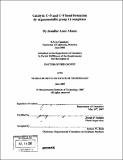| dc.contributor.advisor | Joseph P. Sadighi. | en_US |
| dc.contributor.author | Akana, Jennifer Anne | en_US |
| dc.contributor.other | Massachusetts Institute of Technology. Dept. of Chemistry. | en_US |
| dc.date.accessioned | 2007-11-16T14:29:08Z | |
| dc.date.available | 2007-11-16T14:29:08Z | |
| dc.date.copyright | 2007 | en_US |
| dc.date.issued | 2007 | en_US |
| dc.identifier.uri | http://hdl.handle.net/1721.1/39585 | |
| dc.description | Thesis (Ph. D.)--Massachusetts Institute of Technology, Dept. of Chemistry, 2007. | en_US |
| dc.description | Vita. | en_US |
| dc.description | Includes bibliographical references. | en_US |
| dc.description.abstract | This thesis presents a study of the reaction between an (NHC)gold(I) fluoride complex (NHC = N-heterocyclic carbene) and alkynes (Chapter 1). Gold(I) and fluoride add trans across the triple bond of 3-hexyne and 1-phenyl-l-propyne to form (fluorovinyl)gold(I) complexes, with exclusive geminal arrangement between the phenyl group and gold in the latter case. This addition is reversible, and the (fluorovinyl)gold(I) complexes can extrude alkyne to return (NHC)gold(I) fluoride. Treatment of (fluorovinyl)gold(I) complexes with strong acid protonates the vinylic group with strong acid to afford trans-hydrofluorination. The same fluoroalkene product is obtained by treatment of an (1i2-alkyne)gold(I) complex with the mild HF source Et3N.3HF. Cationic (NHC)gold(I) complexes catalyze the trans-hydrofluorination of internal alkynes with Et3N*3HF (Chapter 2). Sterically demanding, electrophilic supporting ligands and the presence of acid buffers improve reaction efficiency. A study of aryl-substituted alkynes suggests that electron-poor aryl groups favor shorter reaction times and higher regioselectivity of fluorination. A heavily fluorinated phenanthroline ligand supporting a cationic copper(I) catalyst allows efficient functionalization of C-H bonds using sulfonyl azides (Chapter 3). | en_US |
| dc.description.abstract | (cont.) Performing the reaction in 1,1,1,3,3,3-hexafluoroisopropanol solvent is crucial. The intramolecular cyclization of sulfonyl azides through nitrene insertion into proximate benzylic or aliphatic C-H bonds is established, and efficient intermolecular arene amidation was achieved. The best yields result from using electron-rich substrates and electron-poor azides. A small kinetic isotope effect measured for the amidation of benzene indicates that C-H bond activation is probably not the rate-determining step. The presence of a 1,2-shift is consistent with an electrophilic mechanism for arene activation. The formation of both aryl- and benzyl-substituted products from mesitylene indicates that different reaction pathways may compete in the electrophilic amidation process. | en_US |
| dc.description.statementofresponsibility | by Jennifer Anne Akana. | en_US |
| dc.format.extent | 98, [1] leaves | en_US |
| dc.language.iso | eng | en_US |
| dc.publisher | Massachusetts Institute of Technology | en_US |
| dc.rights | M.I.T. theses are protected by copyright. They may be viewed from this source for any purpose, but reproduction or distribution in any format is prohibited without written permission. See provided URL for inquiries about permission. | en_US |
| dc.rights.uri | http://dspace.mit.edu/handle/1721.1/7582 | |
| dc.subject | Chemistry. | en_US |
| dc.title | Catalytic C-N and C-F bond formation by organometallic group 11 complexes | en_US |
| dc.type | Thesis | en_US |
| dc.description.degree | Ph.D. | en_US |
| dc.contributor.department | Massachusetts Institute of Technology. Department of Chemistry | |
| dc.identifier.oclc | 174970084 | en_US |
